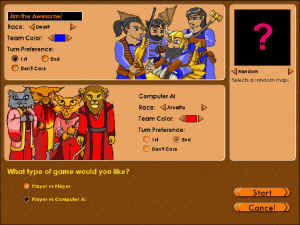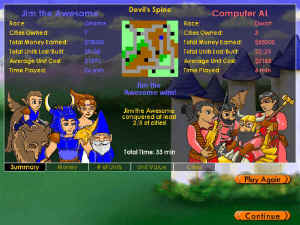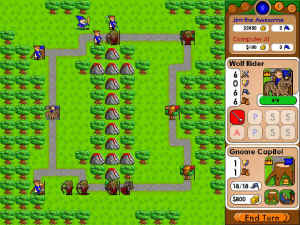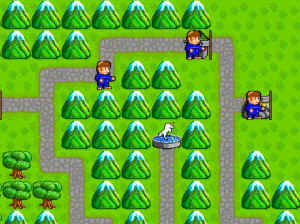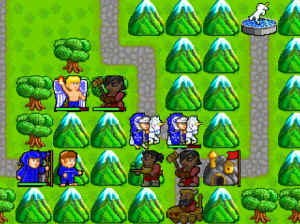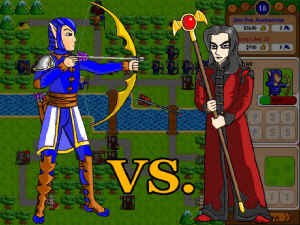|
|
||||||||
FANTASYLAND GOES RETRO FANTASY WARFARE IN LAND OF LEGENDS
On one end of the turn-based, military strategy wargame is the simulation. On the other is Land of Legends. This is not a derogatory comment by any means, as there is plenty of room within the computer gaming world for more than the hard core game for the hard core player. Further, as this one demonstrates, when one leaves the comfort zone of tanks and airplanes represented rigorously, there can be some unexpected fun. As the title indicates, this is a fantasy game, with the expected races dueling for control of any of a number of maps. Most peoples are familiar, starting with the humans of course, along with the elves, dwarves, and orcs. There are some new ones too, added to the Tolkien types. The game has the undead, centered around the vampires and necromancers, and one charming group called the afflicted. Their basic unit is a leper. Land of Legends also introduces a novel feline race of its own, the arcatta, combination of overgrown house kitties and lions, with plenty of magic and mobility but no armor. As with the arcatta, each group has its own strengths and weaknesses. Elves can generate plenty of light, mobility missile "runners," but these seldom survive contact with the enemy in the open. When an undead necromancer or zombie kills a unit, it comes back as one of the undead itself, a reanimated skeleton or a zombie. Often in a fantasy environment, when the designer gives to a race, he takes something away in another, but in Land of Legends, it is not as balanced as in many. Some species have an easier time than the others and humans are one of the stronger; their fireball-throwing, flying archangels are the most impressive units in the game. Additionally, they have "prophets" that are both healers and agitprop specialists for converting occupied cities to human allegiance and production. Surprisingly, what may be the strongest and most enjoyable race are the smallest, the gnomes. Their smallest unit is a "cutpurse" which steals money with each hit on an enemy, so that combat is a matter of profit as well as offense and defense. They also have a unit that, like the human prophet, is good for restoring others to health; the gardener. This little character looks like the Travelocity Roaming Gnome and, as the name suggests, increases the productivity of city it occupies through its penchant for agriculture. Others are surprisingly weak. The elves are among the harder to play, and the dwarves the toughest with which to win. Both, as well as the arcatta, require more finesse and subtlety for victory; if one is going to build a steamroller, it is much more likely to be human or orcish. The game system is very simple. The map has squares instead of hexes, and there are very few types of terrain. Stacking, there is no stackign. Cities are the objectives, but before one can be counted toward victory it has to be "converted," a process that generally takes four turns, but can be hurried if the occupier is especially persuasive, like a prophet, or intimidating, like an archangel or an ogre. In one of the game's more interesting twists, a city produces units corresponding with its population, not its occupier. Thus, an enemy city generates units of the enemy's order of battle, but loyal to the player. There might also be a city or two on the map populated by a third race. More typical for a real-time strategy title, Land of Legends starts off its combatants with next to nothing. One begins with a city, the capital, and no units. These have to be produced, and then dispatched to seize neutral cities, usually populated by one's own people. Cities are both the intermediate objectives, to enhance production, and the final objectives. The winner is the one who controls at least two-thirds of the population centers on the map, and with around ten present, a conflict can go pretty quickly. There is no sequence of play beyond a separation of player turns. A player can move and attack with his units in any order that he desires, producing units with the same freedom too. Combat is between one adjacent unit and another, with additional attackers waiting their turn to attack, possibly facing retaliation from the defender. There is no advance after combat. It is certainly simple. However, as with many simple games, there are special tactics and tricks that belie that. For example, say that enemy has captured one of the player's cities, and is in the process of converting it to his side. The best way to take it back is with a series of attacks, wearing down the occupier, and then committing one more unit to move into the square. Additionally, it can be a good idea to occupy an enemy's city even if there is no chance of holding it, just to prevent the other side from turning out reinforcements there early in the turn. The artificial intelligence responds to such incursions too by trying to take it back, or stop or counterattack the effort before the city falls. That can take pressure off the player's own territories, as the software is predictable, perhaps a little too predictable in fact. Even if the computer's offensive does not entirely stop, at least the player is sure that it will not be reinforced. There is a second aspect of Land of Legends that can be questioned is the combat process. There is no randomized element; one knows the result ahead of time. There is no unexpected success, and no equally surprising setback. Outcomes are predetermined, and it is up to the player to put them in the right times and places to win. The substance of the game is accessible and the mechanisms easy. The appearance harkens back to earlier generations of computer games, from the era of the 486 processor, DOS 3.2, and the dawn of VGA graphics. The look is not crude or primitive; rather, it is stylistically reminiscent of games from fifteen or twenty years ago. The graphics are yet distinctive. Particularly, the unit icons on the map look like toddler versions of combatants, with big heads, and short legs. When they fight, the larger images are more anime in nature, with a touch of humor, one joke apparently at the expense of one very deserving celebrity. Land of Legends is not a serious simulation. In fact, it is neither serious nor a simulation. However, it is a great deal of fun, with a little element of addiction thrown in. Despite the non-randomize combat system, there is always the temptation to see one more matchup; maybe the dwarves can beat the orcs this time. The game has another attraction as well. For a gamer looking for a way to introduce children to the hobby, Land of Legends has a lot of appeal; simple without being stupid, and charming without being childish. Kids will find the wonders of video console by themselves, but might pass up turn-based PC strategy. There is definitely a place for Land of Legends in computer wargaming.
|

